The interaction between tutors and students in Physiotherapy practices
DOI:
https://doi.org/10.24310/RevPracticumrep.v6i2.13185Keywords:
Academic tutor, Professional tutor, Practicum, Practicum students, Interaction, Educational interactionAbstract
The practicum is a fundamental subject in the teaching-learning process in the degrees of our trainees who have the need to link the theoretical knowledge of the curricula of the Physiotherapy degree with the practical situations that occur in external institutions. This study is contextualized in the subject of external practices carried out in the degree of Physiotherapy with the objective of knowing the interactions between the agents (the academic tutor, the professional tutor and the student in practices) involved during the practical stay of the students of the second and fourth year of the degree of physiotherapy. The research is approached from a qualitative-interpretative paradigm with ethnographic approach. Thirty-four interviews were conducted, performing a triangulation among the intervening agents. The study confirms that the interaction between the intervening agents in the subject, are fundamental for the development of the teaching of the student trainee.
Downloads
Metrics
References
Borbély-Pecze, T. B. y Hutchinson, J. (2014). Work-based Learning and Lifelong Guidance Policies. ELGPN Concept Note No. 5. Finlàndia: The European Lifelong Guidance Policy Network (ELGPN).
Braine, M. E. y Parnell, J. (2011). Exploring student’s perceptions and experience of personal tutors. Nurse Education Today, 31 (8), 904-910. http://doi.org/10.1016/j.nedt.2011.01.005
Carless, D. y Boud, D. (2018). The development of student feedback literacy: enabling uptake of feedback. Assessment & Evaluation in Higher Education, 43 (8), 1315-1325. https://doi.org/10.1080/02602938.2018.1463354
Cohen, L. y Manion, L. (2002). Métodos de investigación educativa. Muralla.
Cooper, J., Courtney-Pratt, H. y Fitzgerald, M. (2015). Key in?uences identi?ed by ?rst year undergraduate nursing students as impacting on the quality of clinical placement: A qualitative study. Nurse Education Today, 35 (9), 1004-1008. http://doi.org/10.1016/j.nedt.2015.03.009
Cuadrado, I., Fernández, I., Monroy, F.A. y Montaño, A. (2012). Estilos de aprendizaje del alumnado de Psicopedagogía y su implicación en el uso de las TIC y aprendizaje colaborativo. RED. Revista de Educación a Distancia, 35. http:// ucsj.redalyc.org/articulo.oa?id=54725583002
D’Souza, M., Karkada, S., Parahoo, K. y Venkatesaperumal, R. (2015). Perception of and satisfaction with the clinical learning environament among nursing students. Nurse Education Today, 35 (6), 833-840. http://doi.org/10.1016/j.nedt.2015.02.005
D’Souza, M., Venkatesaperumal, R., Radhakrishnan, J. y Balachandran, S. (2013). Engagement in clinical learning environament among nursing students: Role of nurse sducators. Open Journak of Nursing, 3 (01), 25-32. http://doi.org/10.4236/ojn.2013.31004
Díaz-Bravo, L., Torruco-García, U., Martínez-Hernández, M. y Varela-Ruíz, M. (2013). La entrevista, recurso flexible y dinámico. Investigación en educación médica, 2 (7), 162-167. https://10.1016/S2007-5057(13)72706-6
Dillenbourg, P. (1999). What do you mean by collaborative learning?. En P. Dillenbourg, Collaborative-learning: Cognitive and Computational Approaches. (p. 1-19). Elsevier.
Eichhorst, W., Rodríguez-Planas, N., Schmidl, R. y Zimmermann, K. F. (2015). A road map to vocational education and training in industrialized countries. ILR Review, 68 (2), 314-337. https://doi.org/10.1177%2F0019793914564963
European Centre for the Development of Vocational Training (CEDEFOP). (2011). Glossary - Quality in education and training. Luxemburg: Publications Office of the European Union. http://www.cedefop.europa.eu/en/publications-and- resources/publications/4106
Feixas, M., Jariot, M. y Tomàs-Folch, M. (2015). El pràcticum de pedagogia i educació social: Competències i recursos. Servicio de Publicaciones de la Universdad Autónoma de Barcelona.
Gallego, T. (2007). Bases teóricas y Fundamentos de la Fisioterapia. Editorial Médica Panamericana.
Gairín J., Feixas M., Guillamón C. y Quinquer D. (2003). Elementos para la elaboración de planes de tutoria en la Universidad. Contextos Educativos, 6 (7), 21-42. http://dx.doi.org/10.18172/con.527
Gargallo, B., Pérez, C., Jiménez, M.A., Martínez, N. y Giménez, J.A. (2017). Métodos centrados en el aprendizaje, implicación del alumno y percepción del contexto de aprendizaje de estudiantes universitarios. Educación XXI, 20 (2), 161-187. https://doi.org/10.5944/educxx1.19036
Hascher, T., Cocard, Y. y Moser, P. (2004). Forget about theory-practice is all? Student teachers' learning in practicum. Teachers and teaching, 10 (6), 623-637. https://doi.org/10.1080/1354060042000304800
Hernández, R., Fernández, C. y Baptista, P. (2014). Metodología de la Investigación. McGraw-Hill.
Kolb, D. (1984). Experiential learning. Prentice-Hall.
Martin, J.M. y Trigueros, C. (2016). Mensajería instantánea y construcción compartida de significados: una experiencia de aprendizaje colaborativo en el prácticum de Maestro de Educación Primaria. RED. Revista de Educación a Distáncia, 51, 1-18. http://dx.doi.org/10.6018/red/51/4
Martinez, E. y Raposo M. (2011). Funciones generales de la tutoría en el Prácticum: entre la realidad y el deseo en el desempeño de la acción tutorial. Revista de Educación, 354, 155-181. http://www.revistaeducacion.mec.es/re354/re354_07.pdf
Molina M. (2004). La tutoría, una estrategia para mejorar la calidad de la educación superior. Revistas Universidades, 28, 35-39. http://www.redalyc.org/articulo.oa?id=37302805
Naujokaitien, J.,Tamoli-n. G., Volungevi-ien, A. y Duart, J. (2020). Using learning analytics to engage students: Improving teaching practices through informed ininteractions. Journal of New Approaches in Educational Reserach, 9, (2).: https://doi.org/10.7821/naer.2020.7.561
Ó Lúanaigh, P. (2015). Becoming a professional: What is the influence of registered nurses on nursing students’ learning in the clinical environament?. Nurse Education in Practice 15 (6), 450-456. http://doi.org/10.1016/j.nepr.2015.04.005
Roman J.M. (2003). Modelo CARI de tutoría de alumnos en la universidad: procedimiento de formación de professores mediante “reflexión en grupo sobre la práctica”. Revista Contextos Educativos, 6 (7), 43-64. 10.18172/con.528
Van Bogaert, P., Kowalski, C., Weeks, S., Van heusden, D. y Clarke, S. (2013). The relationship between nurse practice environment, nurse work characteristics, burnout and job outcome and quality of nursing care: A cross-sectional survey. International Journal of Nursing Studies, 50 (12), 1667-1677. http://doi.org/10.1016/j.ijnurstu.2013.05.010
Warner, S. y McGill, I. (1996). Making Sense of Experiential Learning: Diversity in Theory and Practice. Open University Press.
Zabalza, M. A. (2013). El Practicum y las Prácticas en Empresas en la formación universitaria. Narcea Ediciones.
Zabalza, M. A. (2017). El Prácticum en perspectiva: una mirada a su evolución en los últimos 25 años. En González, M., Raposo, M., Erkizia, A., Cebrián, M., Pérez, A., Barberá, M.A., Canet, O. y Zabalza, M.A. (Coord.), XIV Symposium internacional sobre el Prácticum y las Prácticas externas: Recursos para un Prácticum de calidad (p.61-73). Reppe. https://cutt.ly/ZTa1Aaa
Zeichner, K. (2010). Rethinking the connections between campus courses and field experiences in college -and University- based teacher education. Journal of Teacher Education, 61 (1-2), 89-99.
Downloads
Published
How to Cite
Issue
Section
License
Acceptance of the work implies that the author grants Revista Prácticum the exclusive rights to reproduce, distribute and sell his or her work worldwide, both in digital and paper formats, CD-ROM, etc.
Likewise, the authors shall grant Revista Prácticum the rights of dissemination, public communication on the Internet and IT networks, data buses, as well as any other portals or electronic devices for online consultation of its contents and extracts, under the conditions of the portal, repositories or databases where the work is stored.
Revista Prácticum allows authors to publish and disseminate their articles and works on their personal websites, research teams, institutional repositories and scientific databases. All this in accordance with the Creative Commons 4.0 License









8.png)








